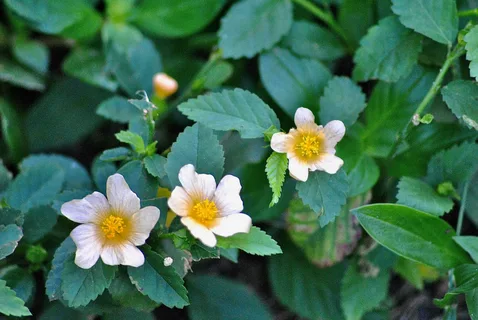Sida acuta common name is wireweed, sidaguri. It’s a flowering plant that belongs to the family Malvaceae.
It is native to the tropics and subtropics around the world, such as Africa, Asia, and Australia, as well as the Americas.
Sida acuta is known for its adaptability and ability to survive in a variety of environmental conditions, such as disturbed habitats, roadways, fields, and even open areas.
This plant usually grows as a short-lived annual or perennial herb, reaching a height of 1 meter or more.
It has slender erect stems with alternately arranged leaves ovate-to-lanceolate in shape with serrated edges, which are usually green.
The flowers of Sida acuta are small, and yellow, with five petals, and they bloom in clumps along the stems. The flowers are followed by small, rounded fruits that contain seeds.
The root system of Sida Acuta is relatively shallow, but it can colonize a variety of soil types.
Different parts of the Sida acuta plant have been used for medicinal purposes in traditional medicine practices.
Various cultures have used this plant to treat various ailments, including fevers, respiratory diseases, digestive issues, skin diseases, and as a tonic.
The traditional use of this plant varies from region to region. Traditionally, Sida acuta is used as a tonic, decoction, infusion, or poultice.
However, it is important to note that scientific research validating the medicinal properties of this plant is still ongoing.
The plant contains various compounds, such as flavonoids and alkaloids, which may contribute to its therapeutic effects.
However, further research is needed to confirm the efficacy and safety of this plant for medicinal purposes.
Sida acuta has been classified as a weed in some regions of the world due to its rapid growth rate and its ability to outcompete and outmaneuver other crops.
Its adaptability and resilience make it difficult for farmers to manage certain types of agricultural conditions.
Sida acuta’s unique characteristics and traditional uses make it a highly sought-after plant in many parts of the world.
It is also a valuable botanical subject for researchers interested in its potential medicinal benefits and its ecological role, as well as its potential applications.
FAQs Related To To Sida Acuta Common Name
Does Sida acuta treat Lyme disease?
Herbal formulas containing Sida acuta are often used to treat Lyme disease and associated infections.
Which fungus can be used to control Sida acuta?
Fusarium lateritium
What is Sida acuta in English?
Common wireweed
What is the name of Sida acuta in Igbo?
Udo
What are the pharmacological uses of Sida acuta?
According to research, Sida acuta’s various components are effective in the treatment of a variety of conditions, such as:
- Neurological disorders
- Headache
- Abnormal vaginal discharge
- Tuberculosis
- Diabetes
- Malaria
- Uterine disorders
- Rheumatic disorders
- Renal inflammation
- Asthma
- Ulcers
- Infections
What is the botanical name of stubborn grass in Nigeria?
Sida Acuta Isekotu
What is turmeric called in Igbo?
Ntu ntu
Other Helpful Blog Posts:
- What Are The Health Benefits Of Pawpaw Seed
- Why Is Oatmeal Not A Healthy Breakfast?
- The Unknown Health Benefits Of Playing Sports
- 10 Things Your Hands Say About Your Health
- 12 Food Combinations That Are Bad For Your Health
- African Black Pepper Health Benefits
- 10 Health Tests You Can Do at Home

